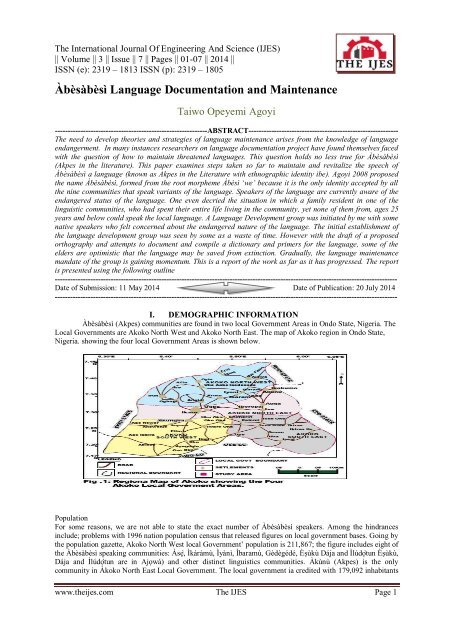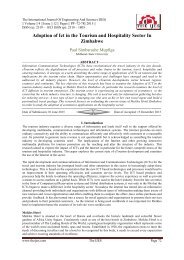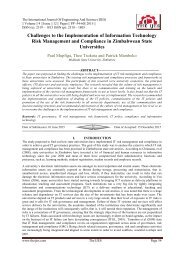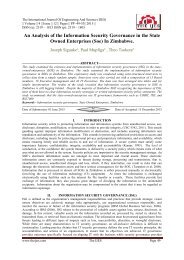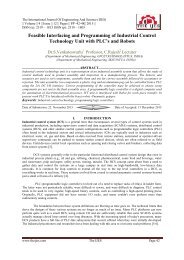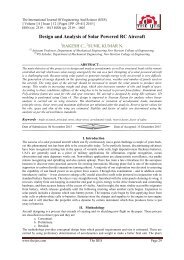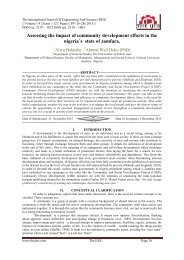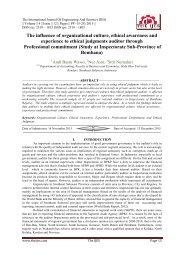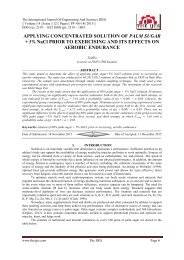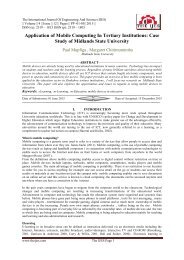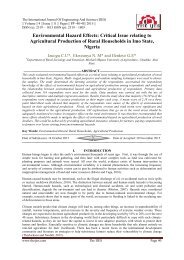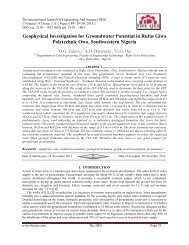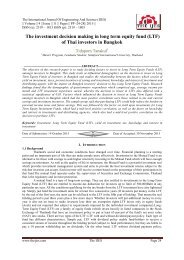Àbèsàbèsì Language Documentation and Maintenance
Create successful ePaper yourself
Turn your PDF publications into a flip-book with our unique Google optimized e-Paper software.
The International Journal Of Engineering And Science (IJES)<br />
|| Volume || 3 || Issue || 7 || Pages || 01-07 || 2014 ||<br />
ISSN (e): 2319 – 1813 ISSN (p): 2319 – 1805<br />
<strong>Àbèsàbèsì</strong> <strong>Language</strong> <strong>Documentation</strong> <strong>and</strong> <strong>Maintenance</strong><br />
Taiwo Opeyemi Agoyi<br />
------------------------------------------------------------ABSTRACT-----------------------------------------------------------<br />
The need to develop theories <strong>and</strong> strategies of language maintenance arises from the knowledge of language<br />
endangerment. In many instances researchers on language documentation project have found themselves faced<br />
with the question of how to maintain threatened languages. This question holds no less true for <strong>Àbèsàbèsì</strong><br />
(Akpes in the literature). This paper examines steps taken so far to maintain <strong>and</strong> revitalize the speech of<br />
<strong>Àbèsàbèsì</strong> a language (known as Akpes in the Literature with ethnographic identity ibe). Agoyi 2008 proposed<br />
the name <strong>Àbèsàbèsì</strong>, formed from the root morpheme Àbèsì ‘we’ because it is the only identity accepted by all<br />
the nine communities that speak variants of the language. Speakers of the language are currently aware of the<br />
endangered status of the language. One even decried the situation in which a family resident in one of the<br />
linguistic communities, who had spent their entire life living in the community, yet none of them from, ages 25<br />
years <strong>and</strong> below could speak the local language. A <strong>Language</strong> Development group was initiated by me with some<br />
native speakers who felt concerned about the endangered nature of the language. The initial establishment of<br />
the language development group was seen by some as a waste of time. However with the draft of a proposed<br />
orthography <strong>and</strong> attempts to document <strong>and</strong> compile a dictionary <strong>and</strong> primers for the language, some of the<br />
elders are optimistic that the language may be saved from extinction. Gradually, the language maintenance<br />
m<strong>and</strong>ate of the group is gaining momentum. This is a report of the work as far as it has progressed. The report<br />
is presented using the following outline<br />
---------------------------------------------------------------------------------------------------------------------------------------<br />
Date of Submission: 11 May 2014 Date of Publication: 20 July 2014<br />
---------------------------------------------------------------------------------------------------------------------------------------<br />
I. DEMOGRAPHIC INFORMATION<br />
<strong>Àbèsàbèsì</strong> (Akpes) communities are found in two local Government Areas in Ondo State, Nigeria. The<br />
Local Governments are Akoko North West <strong>and</strong> Akoko North East. The map of Akoko region in Ondo State,<br />
Nigeria. showing the four local Government Areas is shown below.<br />
Population<br />
For some reasons, we are not able to state the exact number of <strong>Àbèsàbèsì</strong> speakers. Among the hindrances<br />
include; problems with 1996 nation population census that released figures on local government bases. Going by<br />
the population gazette, Akoko North West local Government‟ population is 211,867; the figure includes eight of<br />
the <strong>Àbèsàbèsì</strong> speaking communities: Àsẹ̀, Ìkáràmù, Ìyànì, Ìbaramù, Gèdègédé, Èṣùkù Dája <strong>and</strong> Ìlúdọ̀tun Èṣùkù,<br />
Dája <strong>and</strong> Ìlúdọ̀tun are in Ajọwá) <strong>and</strong> other distinct linguistics communities. Àkùnù (Akpes) is the only<br />
community in Àkoko North East Local Government. The local government ia credited with 179,092 inhabitants<br />
www.theijes.com The IJES Page 1
<strong>Àbèsàbèsì</strong> <strong>Language</strong> <strong>Documentation</strong>...<br />
(NPC 1996). An attempt to use the 1991 census could not help because in 1955 there was a politically motivated<br />
relocation of 3 of the <strong>Àbèsàbèsì</strong> speaking communities from old settlement Àjọwa. Presently there are about<br />
seven distinct languages spoken in Àjọwá. Therefore, we are not able to project <strong>Àbèsàbèsì</strong> speakers‟ population<br />
on the bases of 1991 census.<br />
The maps of Akoko North East <strong>and</strong> North West are shown in figures 2 <strong>and</strong> 3 below<br />
Map of Akoko North West<br />
www.theijes.com The IJES Page 2
<strong>Àbèsàbèsì</strong> <strong>Language</strong> <strong>Documentation</strong>...<br />
<strong>Àbèsàbèsì</strong> Linguistic Situation<br />
www.theijes.com The IJES Page 3
<strong>Àbèsàbèsì</strong> <strong>Language</strong> <strong>Documentation</strong>...<br />
Each of the <strong>Àbèsàbèsì</strong> linguistic communities is multilingual. The speakers acquire Yorùba <strong>and</strong><br />
<strong>Àbèsàbèsì</strong> simultaneously. Yorùba is the language of instruction in primary 1-3 while Yorùba <strong>and</strong> English are<br />
used interchangeably for instruction upper classes in primary school <strong>and</strong> the secondary school. In the<br />
communities, there are speakers of other Nigerian <strong>Language</strong>s such as Hausa, Ebira, Nupe, Igbo, Igala, Ọẁọ́n<br />
Àfá <strong>and</strong> Yoruboid group of speakers. The literate parents speak Yorùbá <strong>and</strong> English to their children. My<br />
interaction with members the communities reveal that they are more interested in speaking Yoruba which is<br />
rated higher than the local <strong>Language</strong>. My experience in Daja in one of my many trips to the community shows<br />
that the youths are not interested in speaking the local language. Interaction with youths met on the field showed<br />
that they were amused. A dedicated member of the <strong>Àbèsàbèsì</strong> <strong>Language</strong> Development Committee, Mrs. Ayisat<br />
Sumonu was humiliated in her community. She was initially seen an unserious person in her community for<br />
being dedicated to the course of developing <strong>and</strong> revitalizing the language.<br />
The People <strong>and</strong> Their <strong>Language</strong><br />
Speakers of each <strong>Àbèsàbèsì</strong> Linguistic community have different names for identifying themselves <strong>and</strong><br />
language. The people of Ìbàràmù, Ìyànì <strong>and</strong> Gèdègédé are the Ìluẹnì; Àsẹ̀ <strong>and</strong> Ìkáràmù are Èkiròmì; Àkùnnù <strong>and</strong><br />
Ìlúdọ̀tun Àjọwá are Akpes; Èṣùkù are the Ọ̀ṣùgù while Dájà people speak Dája. Speakers still regard to Èfìfà as<br />
members of the group though the community lost the <strong>Àbèsàbèsì</strong> as war strategy. The interview I conducted with<br />
my contact persons from each community reveal that the <strong>Àbèsàbèsì</strong> speaking communities were working as a<br />
united people or as a confederation before invasion <strong>and</strong> subversion by Nupe lords <strong>and</strong> colonial rule. Burial<br />
Ceremonies, Marriage rites, New Yam Festival, Masquerade (marking the curt of the dead) <strong>and</strong> other traditional<br />
as well as cultural festival are celebrated in like manner in each of the communities. Dates for the cerebrating<br />
any festival in one community is fixed to avoid clash of interest in any of the Àbèsàbèsi speaking communities.<br />
earn<br />
Political Situation: All <strong>Àbèsàbèsì</strong> speaking communities were in the domain of Akala of Ikaramu during <strong>and</strong><br />
after the reign of Momodu Akombo 1865-1898. There was a move by Late Olusa to form <strong>Àbèsàbèsì</strong> town. But<br />
because of political interest, mismanagement <strong>and</strong> high h<strong>and</strong>edness of the then Akala of Ikaramu the proposal<br />
failed, Ajowa was formed instead. Some leaders of the <strong>Àbèsàbèsì</strong> communities were still loyal <strong>and</strong> subjects to<br />
the Akala. In the 1960s, Akala denied leader of other <strong>Àbèsàbèsì</strong> communities (Ìbaràmù, Ìyànì <strong>and</strong> Gèdègédé)<br />
the right to preside over the customary court in Ikaramu. These leaders revolted; in protest they joined those<br />
who relocated to Ajowa where the act of presiding over the court is by rotation among the leaders of the<br />
member communities. As a result of the high h<strong>and</strong>edness of the Akala he was given the praise singing: igi ń lá<br />
jóeùn balẹ̀; Àkùkọ ńlá jómíràn kọ meaning “a big tree that prevents the race of the sun from shinning on things<br />
under it; a big cock that prevents other cocks from crowing”. There was bad blood, it was difficult to relate with<br />
member communities. All good intentions by individual to reconcile the member communities are always<br />
resisted (Presently, but for the <strong>Àbèsàbèsì</strong> language development project, the people of Ìyànì <strong>and</strong> Ìbaramù are not<br />
too much in good terms).<br />
The Endangered Status of <strong>Àbèsàbèsì</strong> <strong>Language</strong>s<br />
The result of the responses to ability to speak <strong>Àbèsàbèsì</strong> languages conducted in each community is presented<br />
below:<br />
Table I<br />
Community name Age Range<br />
1-10 11-20 21-30 31-40 41-50 51+<br />
Àkùnnù 5% 10% 20% 30% 60% 90%<br />
Àkùnù Ìlúdọ̀tun 0% 0% 5% 20% 30% 65%<br />
Àsẹ̀ 1% 5% 10% 30% 50% 75%<br />
Dája 0% 0% 10% 10% 20% 58%<br />
Gèdègédé 0% 5% 20% 40% 68% 93%<br />
Ekiròmì (Ìkáràmù) 0% 5% 15% 35% 70% 89%<br />
Èṣùkù 0% 0% 2% 10% 30% 57%<br />
Ìbaràmù 0% 10% 35% 40% 70% 95%<br />
Ìyànì 2% 11% 30% 32% 68% 91%<br />
The table shows that the younger generation no longer use the language. The percentage of the computation of<br />
the population interviewed in each age range is discussed below<br />
www.theijes.com The IJES Page 4
<strong>Àbèsàbèsì</strong> <strong>Language</strong> <strong>Documentation</strong>...<br />
Age 1-10: Only insignificant percentages of 1% in Asẹ̀, 2% in Ìyànì <strong>and</strong> 5% in Akunnun <strong>and</strong>Gèdègédé<br />
respectively speak <strong>Àbèsàbèsì</strong> in all other communities 0% of the population investigated speak <strong>Àbèsàbèsì</strong>.<br />
Age range 11-20: indicates that 0% speak <strong>Àbèsàbèsì</strong> in Ìlúdọ̀tun, Dája <strong>and</strong> Èṣùkù. 5% speak <strong>Àbèsàbèsì</strong> in<br />
Àkùnnù <strong>and</strong> Èkiròmì. In this study, 5% is considered an insignificant figure. The % of the population interviewed<br />
from Àkùnnù, Gèdègédé <strong>and</strong> Ìbaràmù show that 10% speak the language while Ìyànì has 11% speakers. If we<br />
compare the outcome in this age range, it shows an improvement in the use of <strong>Àbèsàbèsì</strong> l within some of the<br />
communities.<br />
Age 21-30: In this age range 35% <strong>and</strong> 30% of the population interviewed Ìbaràmù <strong>and</strong> Ìyànì speak <strong>Àbèsàbèsì</strong>.<br />
Àkùnnù <strong>and</strong> Gèdègédé has 20% each, Èkiròmì 15%, Àsẹ̀ <strong>and</strong> Dája 10% each, Àkùnnù Ìlúdọ̀tun 5%, Èṣùkù has<br />
2%. Outcome of the percentage computation of population figure in this age r<strong>and</strong> indicate significant<br />
improvement on the <strong>Àbèsàbèsì</strong> language use in each of the communities.<br />
Age 31-40: The percentage result population interviewed in this age range is higher than the one got from age<br />
range 21-30. Ìbaràmù <strong>and</strong> Gègèdédé has 40% each, Èkiròmì 35% Ìyànì 32%, Àkùnnù <strong>and</strong> Asẹ̀ 30% each,<br />
Ìlúdọ̀tun 20%, Èṣùkù <strong>and</strong> Dája 10% each. The implication of this result is that age plays a significant role in the<br />
native speaker performance of the <strong>Àbèsàbèsì</strong> language.<br />
Age 4--50: The outcome of the computation of the population interviewed in this age range confirms our<br />
observation in the computation of age range 30-40. In this age range Èkiròmì <strong>and</strong> Ìbàramù has 70% each,<br />
Gèdègédé <strong>and</strong> Ìyanì 68% each, Àkùnnù 60% Àsẹ̀ 50%, Èṣùkù <strong>and</strong> Ìlúdọ̀tun 30% each, Dája 20%.<br />
Age 51+% : In this age range we observe that the percentage computation of the population interviewed in all the<br />
<strong>Àbèsàbèsì</strong> linguistic communities are significant; to be precise above 50%. Thus the percentage result is in this<br />
order:Ìbaràmù 95, Gèdègédé 93, Ìyàni 91, Àkùnnù 90, Èkiròmì 88, Àsẹ̀ 75, Ìlúdọ̀tun 65, Dája 58, Èṣùkù 57. The<br />
implication is that the passing of the language from generation to generation in each community in on a declining<br />
trend. The last four decade the language is speedily move towards total extension. If no effort is taken at<br />
documenting <strong>and</strong> revitalizing the language, in the next 50 years when the present speakers might have died, or<br />
shift to other languages, the language may be numbered among the extinct Nigerian language. Efforts at<br />
documenting <strong>and</strong> revitalizing Àbèsèsì will be discussed later in this paper. Before then Let us take a look at the<br />
languages that are threats to <strong>Àbèsàbèsì</strong>.<br />
<strong>Language</strong>s that post threat<br />
The languages that are distinct linguistic form from <strong>Àbèsàbèsì</strong> that threaten the language are the ones<br />
grouped as inter-lingual threats. Such languages are the Nupoid, Yoruboid, English <strong>and</strong> Hausa/Arabic.<br />
<strong>Àbèsàbèsì</strong> communities are located in a geographical area that was one time in history a war zone. The Nupes<br />
oppressed the Akokos for over 50years. Many of the warriors settled in the communities. While some of the<br />
settlers still identify themselves to be of Nupe „Tapa origin, majority of them are subsumed in the community<br />
they find themselves. They are not ready (for political reasons) to trace their migration history to the Nupe<br />
Origin. Such communities are some of the clans in Iyotus in Ikaramu who claim decent from Ile Ife. Any<br />
attempt by any member of the community to link the migration history to „Bida‟ as claimed by some elders,<br />
always lead to protest <strong>and</strong> hot argument.One of the traditional songs by Iyotu women at burial ceremonies is<br />
close to the traditional music of the Nupes. I am still working on a track rendered by a group in Iyotu. The<br />
meaning of the song is still a mystery to me. The performer told me it was her clan‟s original traditional song. I<br />
am still working on the women to give me more of the songs but they needed incentive which I have not been<br />
able to provide.Another language that highly threatened <strong>Àbèsàbèsì</strong> is Yoruba. Before the colonial era, the<br />
Yorubas dominate Akoko L<strong>and</strong> <strong>and</strong> people. Adive J. R. (1998:2) has this to say on the influence of Yoruba on<br />
Ebiras (Adive‟s view of Yoruba influence on Ebira is similar in some respect to the influence of Yoruba on<br />
Àbèesàbèsì):<br />
Yoruba seems to have had more influence …on Ebirain various ways.<br />
For Example, Western Education <strong>and</strong> missionary activities spread<br />
from Yoruba people to Ebiras. Te first schools among the Ebiras were<br />
established by the church Missionary Society (MS) <strong>and</strong> Roman Catholic chievies<br />
Mission. Most teachers in the schools in the early days were Yoruba <strong>and</strong><br />
Yoruba was medium of instruction in the schools for the first three years.<br />
Unlike Ebira, <strong>Àbèsàbèsì</strong> is still under threat from Yoruba. An <strong>Àbèsàbèsì</strong> child needs no formal instruction on<br />
the acquisition of Yoruba. The situation is that an <strong>Àbèsàbèsì</strong> child acquires Yoruba <strong>and</strong> Abèsàbèsì<br />
www.theijes.com The IJES Page 5
<strong>Àbèsàbèsì</strong> <strong>Language</strong> <strong>Documentation</strong>...<br />
simultaneously. Presently most adults feel the community has been bi-lingual from creation. On Friday 5 th of<br />
July at a meeting in the palace of Akala of Ikaramu, one of the chiefs argued that the bilingualism in the<br />
community came as a result of their origin from Ile-Ife. The community leaders claim the real language of the<br />
<strong>Àbèsàbèsì</strong> is Yoruba, he refers to the <strong>Àbèsàbèsì</strong> linguistic form as „Enọ̀‟ secrete language given to the people as<br />
special gift from God. The claim of the community leader informs the deliberate shift from <strong>Àbèsàbèsì</strong> to Yoruba<br />
in the communities.<br />
English is another language that has been a threat to <strong>Àbèsàbèsì</strong>. The ruling power in Ikaramu since Nupe<br />
invasion has been compromising confederacy of his people with invaders. Ikaramu became the seat of<br />
government for the European government. A regiment of the Royal Niger Company was located in Ikaramu.<br />
The barrack was near the present location of Ìbaràmù. The people borrowed many lexical items such as:<br />
ínting „something‟<br />
dínọ̀ „dinner‟<br />
jidínọ̀ eat dinner‟<br />
The influence of English is not much because of the shortness of the period spent in the communities.<br />
Efforts at <strong>Documentation</strong> <strong>and</strong> Revitalisation of <strong>Àbèsàbèsì</strong><br />
There have been various efforts on the linguistic description of <strong>Àbèsàbèsì</strong>. In mid 90s Mr Ajatta of<br />
Ayeteju Ikaramu wrote some Ikaramu lexical items in a note book. The write up was of help to my research in<br />
1996 on Èkiròmì. Aside this effort, many linguists have worked on the <strong>Àbèsàbèsì</strong> lects. There are some<br />
undergraduate long essays in each of the languages In the Deparment of Linguistics <strong>and</strong> <strong>Language</strong>s in Adekunle<br />
Ajasin University Akungba Akoko, Ondo State Nigeria, Ekiti State University Ado Ekiti Nigeria, <strong>and</strong><br />
University of Ilorin, Nigeria. Ibrahim-Arirabiyi (1989) is the first rigorous academic work on the language. His<br />
work is on the Reconstruction of the Akpes. Agoyi (1997, 2008) are other researchs conducted on a lect <strong>and</strong><br />
<strong>Àbèsàbèsì</strong> language respectively. Agoyi (2008)‟s study is on the Phonology of the Vowel Harmony in<br />
<strong>Àbèsàbèsì</strong>. All these researches attempt grammatical analysis of the language. Giwa published of 500 Ìyànì<br />
lexical items in (2010). The book is restricted to only Ìyànì/ Ìluẹni speakers. Many speakers complained of lack<br />
of reading materials in the language. I decided to form an <strong>Àbèsàbèsì</strong> language Development committee after<br />
consultation with people of like mind from each of the <strong>Àbèsàbèsì</strong> linguistic communities in 2009. I coordinate<br />
the committee; Chief Williams W. O. from Ìbaràmu is the chairperson; Mr Ajayi from Ìkáràmù is the secretary.<br />
Other members are at least a representative of each of the speaking community. I fund the group from my<br />
salary.<br />
The Akoko <strong>Language</strong> research committee in the Department of Linguistics <strong>and</strong> <strong>Language</strong>s, Faculty of Arts,<br />
Adekunle Ajasin University Akungba Akoko, was awarded a grant to document Akoko <strong>Language</strong>s. We had<br />
completed the field work already. We are working on the analysis of the data collected. The grant assisted me<br />
to compare my data with the structured data prepared from the University. The incentives given to the resource<br />
persons by the research committee were of much assistance to win the support <strong>and</strong> cooperation of the speakers<br />
of <strong>Àbèsàbèsì</strong>. In addition I use my bus a Mercury villager br<strong>and</strong> to transport the members of the committee to<br />
<strong>and</strong> fro from the meeting venue. In the meeting the chairperson ruled that all discussions have to be done using<br />
<strong>Àbèsàbèsì</strong> as medium of communication. To write reading materials in the language, I proposed orthography for<br />
the language. The proposed orthography was beginner class orthography. The ability of the speakers in reading<br />
<strong>and</strong> writing Yoruba in formal <strong>and</strong> informal education was taken into consideration.<br />
I only proposed new but familiar graphemes for the phonemes that are not found in Yoruba. Such phonemes are:<br />
// /ɔ/ ngọ „drink‟<br />
//nĩĩ/ ningi „reach/get to‟<br />
/ɲ/ /ɲĩ/ nyi „open‟<br />
/ɲõmĩ/ nyomi „fade‟<br />
/ʧ/ /ʧaà/ tṣaà „say‟<br />
èʧì ètṣì „market‟<br />
A booklet titled:<br />
ǸŃ KPAS ÀBÈSÀBÈSÌ MO GBỌ́ ÀBÈSÀBÈSÌ I UNDERSTAND ÀBÈSÀBESÌ<br />
was published to test the orthography in June 2012. The booklet was accepted by all speakers (though they<br />
wanted the booklet to be distributed to them without cost).<br />
There is a collaborative work with the institute of Living tongue in America to write a digital dictionary for the<br />
language. We are working on the lexical items for now. The project has served as a challenge to each <strong>Àbèsàbèsì</strong><br />
speaking community. Members have been gathering to work on the word list I prepared. Youths are getting<br />
challenged to speak the local language. On 29 th December 2012 we held a quiz competition in Ìyànì tagged<br />
Dèdè mí n Dèdè. Although only four of the communities were represented, the program was very interesting.<br />
Ìbaràmù came first, Àkùnnù was second Ìyànì third <strong>and</strong> Ikáràmù was forth.<br />
www.theijes.com The IJES Page 6
<strong>Àbèsàbèsì</strong> <strong>Language</strong> <strong>Documentation</strong>...<br />
Unlike before, it is fashionable to give a child an <strong>Àbèsàbèsì</strong> name now. There are names such as:<br />
English Orthography Proposed Orthography Gloss<br />
Chreno Tṣẹ̀rẹ̀nọ „mend/adore me<br />
Osumena Oòsùmẹná „God did it for me /God is good to me‟<br />
Osunkona Oòsùńkọǹá „Thank God‟<br />
Dosubo Doòsùbò Hold God/Trust in God<br />
Local songs <strong>and</strong> dancing steps are now welcome phenomenon in entertaining guests in Social gathering.<br />
Presently, in Gèdègédé community meetings are conducted using <strong>Àbèsàbèsì</strong> as medium of expression. Any<br />
member who is not competent in the language is not allowed to contribute to discussions.To actualise my dream<br />
on revitalizing <strong>Àbèsàbèsì</strong> I contacted the president of the Living Tongue Institute in America; I signed an<br />
agreement with the institute as a Living Tongue Activist to compile a multi-dialectal digital dictionary for the<br />
language. The project is strictly owned by the community. All members of the <strong>Àbèsàbèsì</strong> language<br />
Development committee are working as a team on data collection, transcription, edition etc. Other community<br />
members have offered to join the group to enrich the production of the dictionary. We all hope that one day<br />
somebody or the government will assist to sponsor our projects.<br />
̀<br />
REFERENCES<br />
[1] Agoyi, T.O (1998) Ìsọ̀rì Ọ̀ rọ̀ Nínú Èkiròmì Unpublished M.A Thesis, Department of Linguistics <strong>and</strong><br />
[2] Nigerian <strong>Language</strong>s, University of Ilorin: Nigeria.<br />
[3] Agoyi, T.O (2001) Category of Number in Ekiromi, in Inquiry in African <strong>Language</strong>s <strong>and</strong> Literatures<br />
4:64-80.<br />
[4] Agoyi T.O. (2008) „The Phonology of the Vowel Harmony in À bè sàbèsì‟ Ph . D Thesis Adekunle<br />
Ajasin University, Akungba- Akoko. Agoyi T.O (2010)<br />
[5] Agoyi T.O (2010) “ ATR + Roundness in Abesabesi: The case of Akpes” in Akungba Journal of<br />
[6] Linguistics <strong>and</strong> Literature August 2010:85-102 Agoyi T. O (2012) “Morphology of <strong>Àbèsàbèsì</strong><br />
Numerals: A Case Study of Èkiròmì” in International Journal of Business <strong>and</strong> Social Science. Vol. 3<br />
No. 20 (Special Issue-October 2012)<br />
[7] Agoyi T. O. (2012) “Ìṣùaà Numerals System” Scottish Journal of Arts, Social Sciences <strong>and</strong> Scientific<br />
[8] Studies (SJASS). Vol. 7 No. 1.<br />
[9] Agoyi T. O. (2012) „ ATR+ RUOUND <strong>and</strong> Low Vowel Harmony In À bèsàbèsì : A Case Study Of<br />
Ọ̀ ṣùgù‟ in International Journal of Business <strong>and</strong> Social Science. Vol. 3 No. 21 (Special Issue-<br />
November 2012)<br />
[10] Agoyi T. O. “<strong>Àbèsàbèsì</strong> Orthography: A Proposal” in IOSR Journal Of Humanities And Social<br />
Science (JHSS) ISSN: 2279-0837, ISBN: 2279-0845. Volume 6, Issue 2 (Nov. - Dec. 2012), PP 41-45;<br />
www.Iosrjournals.Org<br />
[11] Agoyi T . O. ( June, 2012) ǸŃ Kpási <strong>Àbèsàbèsì</strong> : Mo Gbọ́ <strong>Àbèsàbèsì</strong>: I Underst<strong>and</strong> <strong>Àbèsàbèsì</strong><br />
inOyebade F. O. <strong>and</strong> Adebowale O. (ed) booklet in honour of His Royal Highness, Ọba O. Momodu<br />
Osona I The Akala of Ikaramu, all <strong>Àbèsàbèsì</strong> kings, all people at home <strong>and</strong> in diaspora, Printed in<br />
Ikàrẹ́.<br />
[12] Eno-Abasi Urua (2011) “A phonological sketch of Ù dá” A paper presented at West African Linguistic<br />
Conference, held on 30 th April, 2011 at University of London UK<br />
[13] Oyebade F,O, <strong>and</strong> Agoyi T.O (20110” The Pronoun ,Tense <strong>and</strong> aspect System of Ukare In<br />
[14] Oyebade <strong>and</strong> Olumuyiwa O. T (2010:221-237) New Findings in the Study of<br />
Nigerian <strong>Language</strong>s <strong>and</strong> Literature. Festsch in honour of Oladele Awobuluyi Montem Paperback:<br />
Akure. Oyebade F. O <strong>and</strong> Agoyi T. O. 2012 „The Linguistic Form <strong>and</strong> Computational System of<br />
[15] Numerals In Yoruba <strong>and</strong> Èkiròmì: A Comparison‟ in Journal of African Studies Ahumibe, Chiedozie<br />
(2002) Orthography of Ìluẹnì: A proposal. Undergraduate Long Essay,Department of Linguistics <strong>and</strong><br />
African <strong>Language</strong>s University of Ibadan, Nigeria.Ibrahim-Arirabiyi, F (1989) A Comparative<br />
Reconstruction of Akpes Lects, MA Thesis, Department of Linguistics <strong>and</strong> Nigerian <strong>Language</strong>s,<br />
University of Port Harcourt, Nigeria.<br />
www.theijes.com The IJES Page 7


